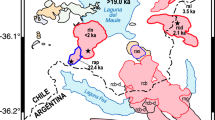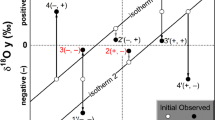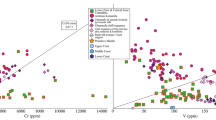Abstract
The Li concentrations in natural zircons vary by over six orders of magnitude, and Li intra-zoning within zircon has been used to model temperature–time histories in the crust, where the inputs to these T–t models presume some initial Li content of intra-zircon domains. This potential wealth of information may be further improved with experimental studies that characterize Li partitioning between zircon and melt. Here we report experiments that systematically quantify Li partitioning between zircon and different silicate melts as a function of temperature. We also explored how Li in zircon is structurally accommodated and the possible element(s) that influence Li incorporation. Zircon–melt partitioning is reported in four different melt compositions, with ASI values (molar ratio of Al2O3/(Na2O + K2O + CaO)) ranging from 0.56 to 1.44. The experiments were performed in a piston–cylinder device at 1000, 1100, 1200, and 1300 °C, and at a constant pressure of 1 GPa. Results of experiments show that the zircon–melt Li partition coefficient is not dependent on melt composition, but shows a negative relationship to temperature. This means the large range of Li concentrations in natural zircon is probably due to the combined factors of crystallization temperature and the original melt Li contents. We used our data to derive an empirical equation to describe the relationship of Li partitioning between zircon and melt (DLi) and temperature (K): log10(DLi) = (5918 ± 1479)/ T − (6.91 ± 1.05). Through experiments with or without P added to the starting rock mix, we found that P-doped experiments yield lower DLi than those without P, which implies that Li competes with P for rare earth element (REE3+) charge balance. To test the influence of H2O content of the melt on Li partitioning in zircon, we also explored melts with varying H2O contents (nominally 0, 5 wt.%, and 10 wt.%); results indicate that Li partitioning in zircon is not dependent on the H2O content of the melt. This method lays the groundwork to estimate the concentration of Li in melt that crystallized zircon, given the concentration of Li in zircon and an independent temperature estimate, provided that no post-crystallization modification of Li in zircon has occurred. We applied this equation to Hadean, Archean, and modern zircons and found that the predicted [Li]melt for Jack Hills zircons, Archean TTG and sanukitoid are one order magnitude higher than the modern crust.








Similar content being viewed by others
References
Ayers JC, Brenan JB, Watson EB, Wark DA, Minarik WG (1992) A new capsule technique for hydrothermal experiments using the piston-cylinder apparatus. Am Mineral 77(9–10):1080–1086
Boehnke P, Watson EB, Trail D, Harrison TM, Schmitt AK (2013) Zircon saturation re-revisited. Chem Geol 351:324–334
Bouvier A-S, Ushikubo T, Kita NT, Cavosie AJ, Kozdon R, Valley JW (2012) Li isotopes and trace elements as a petrogenetic tracer in zircon: insights from Archean TTGs and sanukitoids. Contrib Miner Petrol 163(5):745–768
Brant C, Coogan L, Gillis K, Seyfried WE, Pester N, Spence J (2012) Lithium and Li-isotopes in young altered upper oceanic crust from the East Pacific Rise. Geochim Cosmochim Acta 96:272–293
Cavosie AJ, Valley JW, Wilde SA (2006) Correlated microanalysis of zircon: Trace element, δ18O, and U-Th–Pb isotopic constraints on the igneous origin of complex> 3900 Ma detrital grains. Geochim Cosmochim Acta 70(22):5601–5616
Chan LH, Edmond JM, Thompson G, Gillis K (1992) Lithium isotopic composition of submarine basalts: implications for the lithium cycle in the oceans. Earth Planet Sci Lett 108(1):151–160. https://doi.org/10.1016/0012-821X(92)90067-6
Cherniak D, Watson E (2010) Li diffusion in zircon. Contrib Miner Petrol 160(3):383–390
Chowdhury W, Trail D, Bell E (2020) Boron partitioning between zircon and melt: insights into Hadean, modern arc, and pegmatitic settings. Chem Geol 551:19763
Cooper KM (2019) Time scales and temperatures of crystal storage in magma reservoirs: implications for magma reservoir dynamics. Phil Trans R Soc A 377(2139):20180009
De Hoog J, Lissenberg CJ, Brooker R, Hinton R, Trail D, Hellebrand E (2014) Hydrogen incorporation and charge balance in natural zircon. Geochim Cosmochim Acta 141:472–486
Dellinger M, Bouchez J, Gaillardet J, Faure L, Moureau J (2017) Tracing weathering regimes using the lithium isotope composition of detrital sediments. Geology 45(5):411–414
Ferry J, Watson E (2007) New thermodynamic models and revised calibrations for the Ti-in-zircon and Zr-in-rutile thermometers. Contrib Miner Petrol 154(4):429–437
Fu B, Page FZ, Cavosie AJ, Fournelle J, Kita NT, Lackey JS, Wilde SA, Valley JW (2008) Ti-in-zircon thermometry: applications and limitations. Contrib Miner Petrol 156(2):197–215
Grimes CB, Ushikubo T, John BE, Valley JW (2011) Uniformly mantle-like δ18O in zircons from oceanic plagiogranites and gabbros. Contrib Miner Petrol 161(1):13–33
Hanchar JM, Finch RJ, Hoskin PWO, Watson EB, Cherniak DJ, Mariano AN (2001) Rare earth elements in synthetic zircon: part 1. Synthesis, and rare earth element and phosphorus doping. Am Mineral 86(56):667–680
Hoskin PW, Kinny PD, Wyborn D, Chappell BW (2000) Identifying accessory mineral saturation during differentiation in granitoid magmas: an integrated approach. J Petrol 41(9):1365–1396
Ickert R, Williams I (2011) U-Pb zircon geochronology of Silurian-Devonian granites in southeastern Australia: implications for the timing of the Benambran Orogeny and the I–S dichotomy. Aust J Earth Sci 58(5):501–516
King EM, Valley JW, Davis DW, Edwards GR (1998) Oxygen isotope ratios of Archean plutonic zircons from granite–greenstone belts of the Superior Province: indicator of magmatic source. Precambr Res 92(4):365–387
Krienitz M-S, Garbe-Schönberg C-D, Romer R, Meixner A, Haase K, Stroncik NA (2012) Lithium isotope variations in ocean island basalts—implications for the development of mantle heterogeneity. J Petrol 53(11):2333–2347
Li S-Q, Schmitt AK (2021) Lithium distribution and isotopic composition in zircon megacrysts as constraints for their mantle origin and volcanic transfer timescales. Geochim Cosmochim Acta 313:173–194
Li X-H, Li Q-L, Liu Y, Tang G-Q (2011) Further characterization of M257 zircon standard: a working reference for SIMS analysis of Li isotopes. J Anal at Spectrom 26(2):352–358
Liu X-M, Rudnick RL (2011) Constraints on continental crustal mass loss via chemical weathering using lithium and its isotopes. Proc Natl Acad Sci 108(52):20873–20880
Marschall HR, Wanless VD, Shimizu N, Von Strandmann PAP, Elliott T, Monteleone BD (2017) The boron and lithium isotopic composition of mid-ocean ridge basalts and the mantle. Geochim Cosmochim Acta 207:102–138
Paton C, Hellstrom J, Paul B, Woodhead J, Hergt J (2011) Iolite: freeware for the visualisation and processing of mass spectrometric data. J Anal at Spectrom 26(12):2508–2518
Pietranik A, Storey C, Koepke J, Lasalle S, Eimf, (2017) Zircon record of fractionation, hydrous partial melting and thermal gradients at different depths in oceanic crust (ODP Site 735B, South-West Indian Ocean). Contrib Miner Petrol 172(2):10. https://doi.org/10.1007/s00410-016-1324-y
Pistiner JS, Henderson GM (2003) Lithium-isotope fractionation during continental weathering processes. Earth Planet Sci Lett 214(1):327–339. https://doi.org/10.1016/S0012-821X(03)00348-0
Plank T (2014) The chemical composition of subducting sediments. Treatise Geochem 4:607–629
Rubin AE, Cooper KM, Till CB, Kent AJ, Costa F, Bose M, Gravley D, Deering C, Cole J (2017) Rapid cooling and cold storage in a silicic magma reservoir recorded in individual crystals. Science 356(6343):1154–1156
Rudnick R, Gao S (2003) Composition of the continental crust. Treatise Geochem 3:1–64
Rudnick RL, Tomascak PB, Njo HB, Gardner LR (2004) Extreme lithium isotopic fractionation during continental weathering revealed in saprolites from South Carolina. Chem Geol 212(1):45–57. https://doi.org/10.1016/j.chemgeo.2004.08.008
Seitz H-M, Woodland AB (2000) The distribution of lithium in peridotitic and pyroxenitic mantle lithologies—an indicator of magmatic and metasomatic processes. Chem Geol 166(1–2):47–64
Sliwinski JT, Kueter N, Marxer F, Ulmer P, Guillong M, Bachmann O (2018) Controls on lithium concentration and diffusion in zircon. Chem Geol 501:1–11. https://doi.org/10.1016/j.chemgeo.2018.09.038
Tang M, Rudnick RL, McDonough WF, Bose M, Goreva Y (2017) Multi-mode Li diffusion in natural zircons: evidence for diffusion in the presence of step-function concentration boundaries. Earth Planet Sci Lett 474:110–119
Teng F-Z, McDonough W, Rudnick R, Dalpé C, Tomascak P, Chappell B, Gao S (2004) Lithium isotopic composition and concentration of the upper continental crust. Geochim Cosmochim Acta 68(20):4167–4178
Trail D, Thomas JB, Watson EB (2011) The incorporation of hydroxyl into zircon. Am Miner 96(1):60–67
Trail D, Cherniak DJ, Watson EB, Harrison TM, Weiss BP, Szumila I (2016) Li zoning in zircon as a potential geospeedometer and peak temperature indicator. Contrib Miner Petrol 171(3):25. https://doi.org/10.1007/s00410-016-1238-8
Trail D, Tailby N, Wang Y, Mark Harrison T, Boehnke P (2017) Aluminum in zircon as evidence for peraluminous and metaluminous melts from the Hadean to present. Geochem Geophys Geosyst 18(4):1580–1593
Ushikubo T, Kita NT, Cavosie AJ, Wilde SA, Rudnick RL, Valley JW (2008) Lithium in Jack Hills zircons: evidence for extensive weathering of Earth’s earliest crust. Earth Planet Sci Lett 272(3):666–676
Wang Y, Trail D (2019) Aluminum partitioning between zircon and haplogranitic melts: the influence of temperature and melt composition. Chem Geol 511:71–80. https://doi.org/10.1016/j.chemgeo.2019.02.016
Watson EB (1979) Zircon saturation in felsic liquids: experimental results and applications to trace element geochemistry. Contrib Miner Petrol 70(4):407–419
Watson EB, Harrison TM (1983) Zircon saturation revisited: temperature and composition effects in a variety of crustal magma types. Earth Planet SCi Lett 64(2):295–304
Yakob JL, Feineman MD, Deane JA, Eggler DH, Penniston-Dorland SC (2012) Lithium partitioning between olivine and diopside at upper mantle conditions: an experimental study. Earth Planet Sci Lett 329–330:11–21. https://doi.org/10.1016/j.epsl.2012.01.035
Acknowledgements
This work was supported by NSF grants EAR-1447404 and EAR-1650033. We are very grateful for thorough reviews by John C. Ayers and Elias Bloch and comments by the handling editor, Othmar Müntener, on an earlier version of this manuscript.
Author information
Authors and Affiliations
Corresponding author
Additional information
Communicated by Othmar Müntener.
Publisher's Note
Springer Nature remains neutral with regard to jurisdictional claims in published maps and institutional affiliations.
Supplementary Information
Below is the link to the electronic supplementary material.
Rights and permissions
About this article
Cite this article
Wang, Y., Trail, D. Experimental partitioning of Li between zircon and different silicate melts: implications for Li contents in the Hadean and modern crust. Contrib Mineral Petrol 177, 15 (2022). https://doi.org/10.1007/s00410-021-01877-3
Received:
Accepted:
Published:
DOI: https://doi.org/10.1007/s00410-021-01877-3




